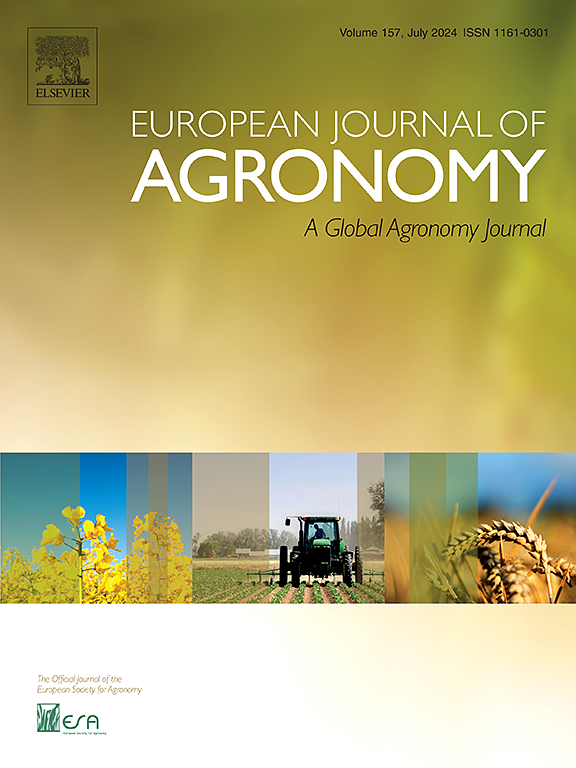在干旱和半干旱地区,秸秆还田可以通过调节土壤细菌和改善土壤性质来提高玉米产量
IF 4.5
1区 农林科学
Q1 AGRONOMY
引用次数: 0
摘要
研究发现,秸秆还田有利于土壤肥力和作物产量,但秸秆还田如何影响微生物群落,从而调节旱地玉米连作系统下作物产量的土壤因子,目前仍不清楚。为了填补这一空白,我们建立了一个为期 6 年的田间试验,采用五种秸秆还田量(T0、T1、T2、T3 和 T4,分别代表 0、3000、6000、9000 和 12000 kg ha-1 的秸秆),研究秸秆还田对土壤性质、酶、细菌群落组成和多样性以及作物产量的影响。我们的分析表明,与 T0 相比,秸秆还田处理下的土壤有机碳(SOC)、全氮(TN)和全磷(TP)含量分别显著增加了 1-8%、5-25% 和 2-9%,土壤过氧化氢酶、脲酶和碱性磷酸酶活性至少增加了 34.00%。此外,在 T1-T4 处理中,作物产量显著增加了 4.23-12.00%,并且与 SOC、TN 和 TP 呈高度显著的关系。重要的是,我们发现秸秆还田极大地改变了参与碳氮循环的细菌群落,它们的丰度因秸秆还田量的不同而产生强烈反应。例如,秸秆投入增加了蛋白质细菌(+2.64-5.57 %)、酸性细菌(+3.82-13.83 %)和类杆菌(+15.37-30.49 %)的丰度。同样,秸秆施用量增加了细菌多样性指数(Shannon,2.65-10.93 %;Chao1,13.47-18.50 %),并与 SOC、TN 和 TP 含量呈显著正相关。结构方程模型(SEM)显示,秸秆还田管理措施通过影响土壤特性或细菌群落对作物产量产生了积极的间接影响。总之,我们的研究结果揭示了不同秸秆还田率下细菌群落多样性与土壤因子和作物产量的共同关联和变化,这些发现为半干旱地区制定更好的秸秆还田策略和可持续农业提供了启示和选择。本文章由计算机程序翻译,如有差异,请以英文原文为准。
Straw return can increase maize yield by regulating soil bacteria and improving soil properties in arid and semi-arid areas
Straw return has been found to benefit soil fertility and crop yield, however, by which it affects microbial communities to mediate soil factors driving crop yields under maize continuous cropping systems in dryland areas is still unclear. To fill this gap, a 6-year field experiment was established with five straw return amounts (T0, T1, T2, T3, and T4, representing 0, 3000, 6000, 9000, and 12,000 kg ha−1 of straw, respectively), and investigated the effects of on soil properties, enzymes, bacterial community composition and diversity, and crop yields. Our analysis showed that soil organic carbon (SOC), total nitrogen (TN), and total phosphorus (TP) contents significantly increased by 1–8 %, 5–25 %, and 2–9 % under straw return treatments, respectively, compared to the T0, and soil catalase, urease, and alkaline phosphatase activities increased by at least 34.00 %. Additionally, crop yield significantly increased by 4.23–12.00 % under T1-T4 treatments, and showed highly significant relationships with SOC, TN, and TP. Importantly, we found straw return significantly altered the community of bacteria involved in the carbon and nitrogen cycle, and their abundance of strong responses depending on the amounts of straw return. For example, straw input increased the abundance of Proteobacteria (+2.64–5.57 %), Acidobacteria (+3.82–13.83 %), and Bacteroidetes (+15.37–30.49 %). Similarly, the amount of straw application increased the bacterial diversity indexes (Shannon, 2.65–10.93 %; Chao1, 13.47–18.50 %), and had significant positive correlations with SOC, TN, and TP contents. Structural equation models (SEM) revealed that straw return management practice had positive and indirect effects on crop yields by influencing soil properties or the bacteria community. In conclusion, our findings revealed common associations and variations of bacterial community diversity with soil factors and crop yields at different straw return rates, and these findings provide insights and options for the development of better straw return strategies and sustainable agriculture in semi-arid regions.
求助全文
通过发布文献求助,成功后即可免费获取论文全文。
去求助
来源期刊

European Journal of Agronomy
农林科学-农艺学
CiteScore
8.30
自引率
7.70%
发文量
187
审稿时长
4.5 months
期刊介绍:
The European Journal of Agronomy, the official journal of the European Society for Agronomy, publishes original research papers reporting experimental and theoretical contributions to field-based agronomy and crop science. The journal will consider research at the field level for agricultural, horticultural and tree crops, that uses comprehensive and explanatory approaches. The EJA covers the following topics:
crop physiology
crop production and management including irrigation, fertilization and soil management
agroclimatology and modelling
plant-soil relationships
crop quality and post-harvest physiology
farming and cropping systems
agroecosystems and the environment
crop-weed interactions and management
organic farming
horticultural crops
papers from the European Society for Agronomy bi-annual meetings
In determining the suitability of submitted articles for publication, particular scrutiny is placed on the degree of novelty and significance of the research and the extent to which it adds to existing knowledge in agronomy.
 求助内容:
求助内容: 应助结果提醒方式:
应助结果提醒方式:


